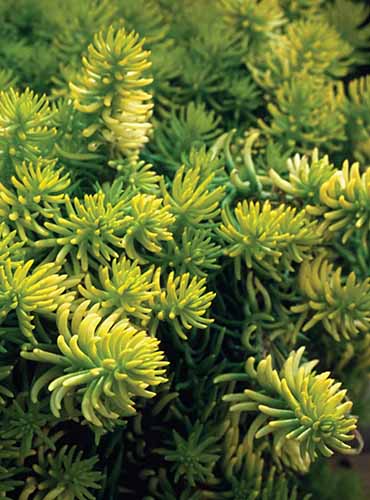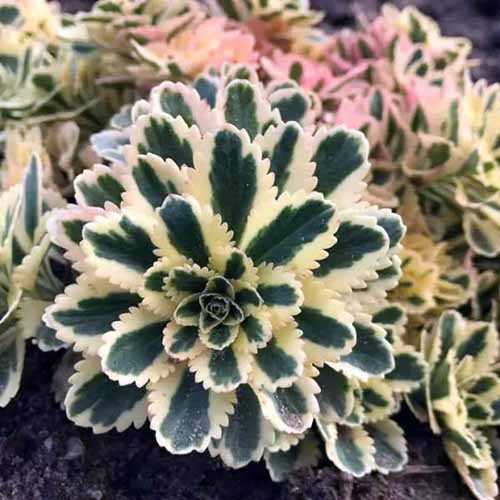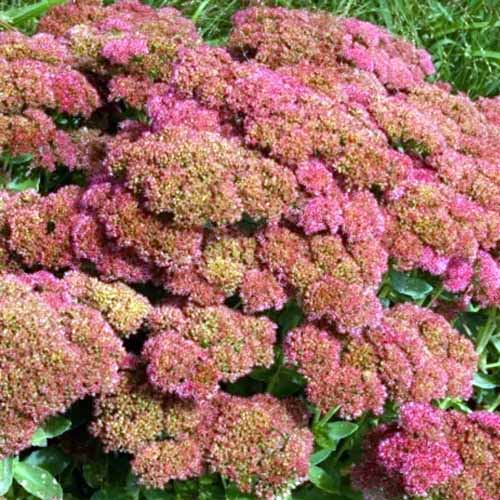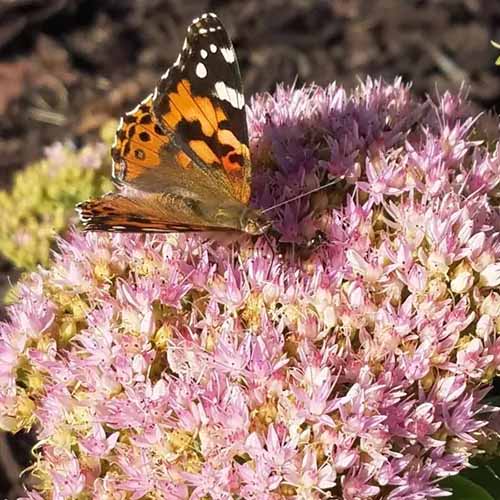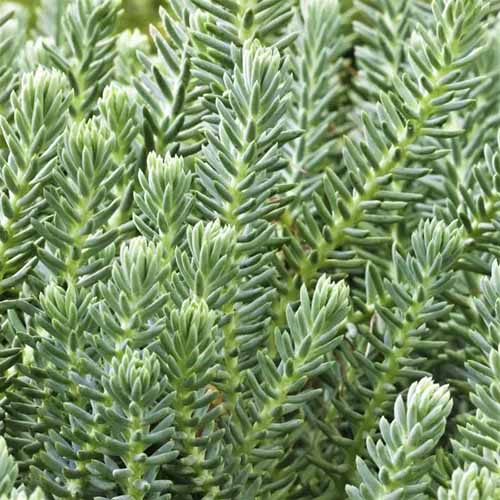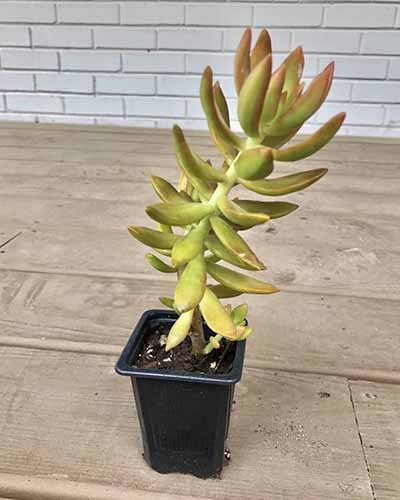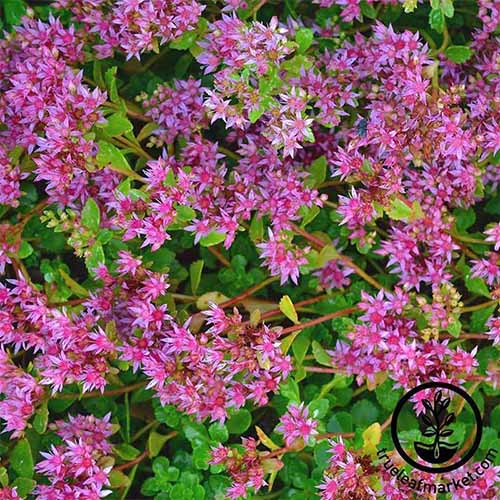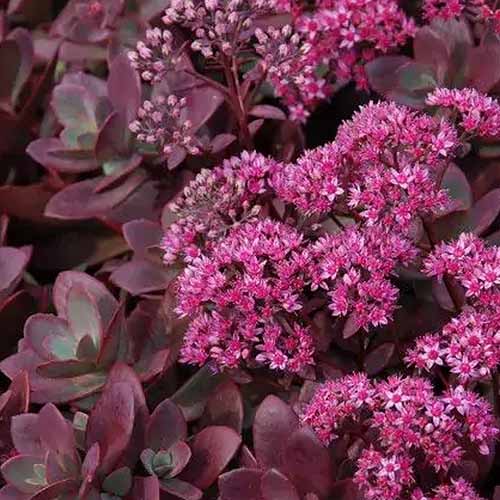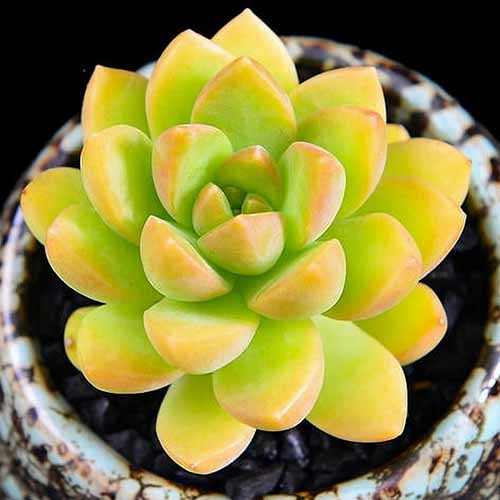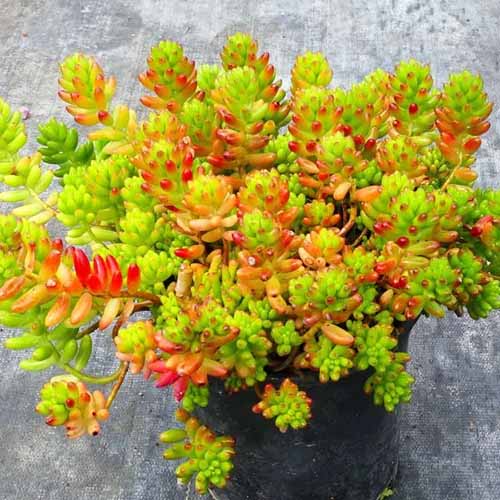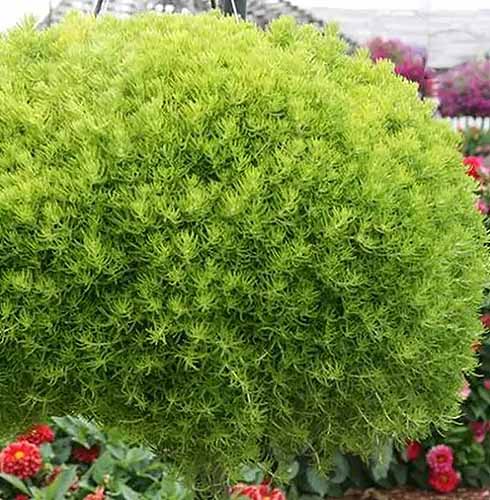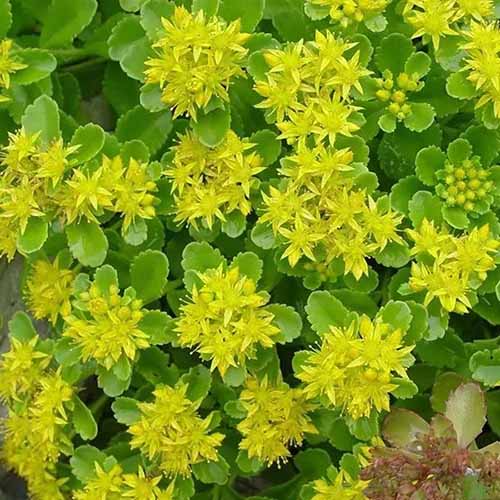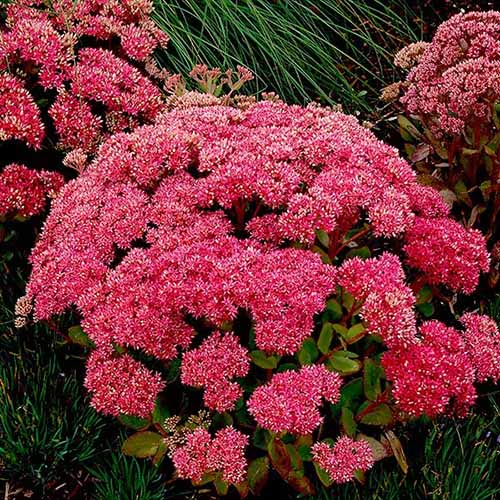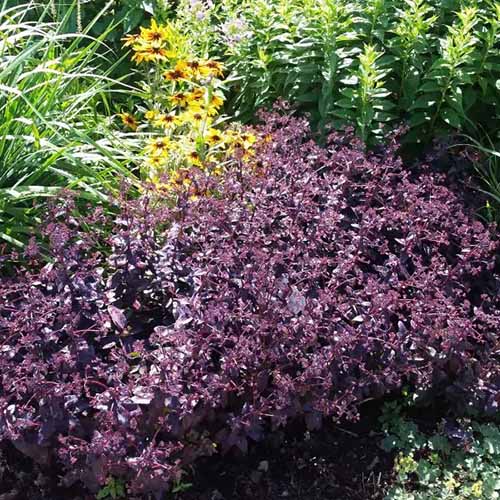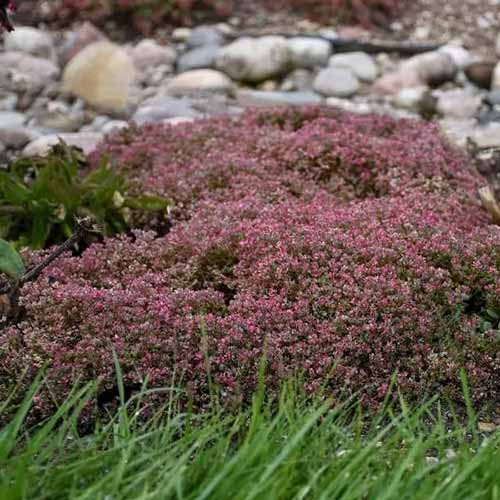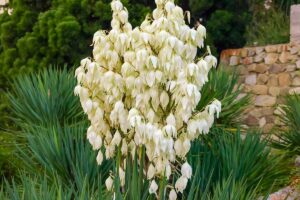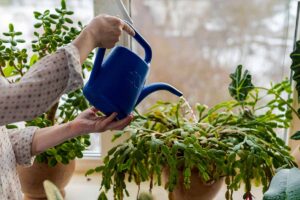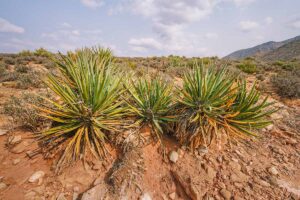Flowering sedums, aka stonecrops, are succulents with fleshy leaves and stems.
The Sedum genus is in the Crassulaceae family of plants and contains approximately 500 species, many of which have been reclassified into the Hylotelephium genus.
These water-wise perennials prefer full sun to part shade placements and sandy, well-draining soil.
There are sedum varieties for every USDA Hardiness Zone from 3 to 10, and species and cultivars with heights ranging from three to 24 inches.
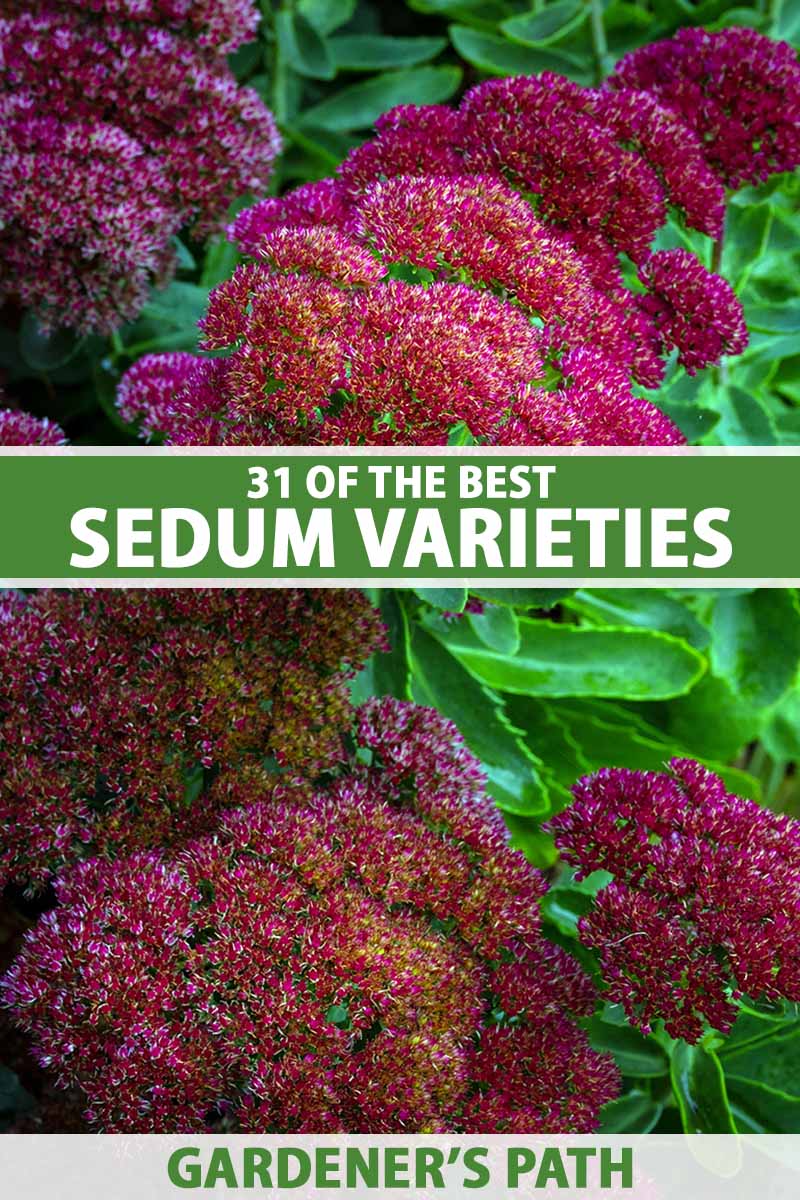
We link to vendors to help you find relevant products. If you buy from one of our links, we may earn a commission.
The smallest types make outstanding ground covers that inhibit erosion. In addition, their shallow roots make them good companions for bulbs that can sprout easily between them.
Our guide to growing sedum shares all you need to know to plant and care for your own.
This article presents 31 of the best sedum varieties for outdoor and indoor cultivation.
Here are our favorites:
31 of the Best Varieties of Sedum
The following species and cultivars offer fabulous foliage and flowers for the summer-to-fall landscape.
Ready to look at the exciting highlights of each. Let’s get right to our list!
1. Angelina
Mat-forming Sedum rupestre ‘Angelina’ has needle-like leaves in a bright shade of chartreuse, starry yellow summer blossoms, and reddish hues in the fall in the coldest regions. It prefers a full-sun placement.
‘Angelina’ is suited to Zones 5 to 8, where it grows to mature dimensions of four to six inches tall and 12 to 24 inches wide.
Use as a companionable, weed-suppressing ground cover in bulb gardens. Sow it in the crevices between stones in rockeries and weave brilliant swaths of color across roof gardens.
‘Angelina’ is available from Burpee.
2. Atlantis
S. takesimense (syn. Phedimus kamtschaticus) ‘Nonsitnal,’ aka Atlantis™ is a ground-covering sedum with cream and green rosette-style foliage, yellow flowers in summer, and burgundy, purple, and red fall hues. It prefers full sun.
Atlantis™ grows in Zones 4 to 9, reaching a height of four to six inches with a spread of 10 to 12 inches.
With its variegated foliage, Atlantis™ is a showy specimen in beds, borders, and rock gardens.
Atlantis™ is available from Nature Hills.
3. Autumn Charm
Sedum ‘Lajos’ (syn. Hylotelephium ‘Lajos’) aka Autumn Charm, is an upright, clumping variety with rosy late-season blooms and blue-green leaves with eye-catching cream margins. In autumn, the flowers deepen to a rich rust red.
Plants grow in Zones 3 to 9 and reach heights of 14 to 18 inches with a spread of 12 to 18 inches. They have exceptional drought tolerance.
The flattened, corymb flower heads make for a dense, uniform ribbon of color in beds and borders.
Autumn Charm sedum is available from Nature Hills Nursery.
4. Autumn Fire
S. spectabile (syn. H. spectabile) ‘Autumn Fire,’ has an upright, clumping growth habit. Dense, rose-colored flower heads shade to coppery red in the fall.
Plants grow well in Zones 3 to 9 and reach heights of 12 to 24 inches tall with an equally wide spread.
Similar to ‘Autumn Joy’ described below, ‘Autumn Fire’ is exceptionally sturdy and drought tolerant.
Showcase its bright blooms as bed specimens and in mass-planted borders.
‘Autumn Fire’ is available from Nature Hills Nursery.
5. Autumn Joy
Upright, clumping Sedum (syn. Hylotelephium) ‘Herbstfreude’ aka ‘Autumn Joy,’ has flowers that shade from pink to rose-red to copper-red as the season draws to a close.
Plants are suited to Zones 3 to 9. Heights range from 18 and 24 inches with an equal spread.
Plants are sturdy and drought-tolerant, and show well planted en masse along walkways and as a specimen among other seasonal blooms.
‘Autumn Joy’ is available from Nature Hills.
Learn more about growing ‘Autumn Joy’ in our guide.
6. Blue Spruce
S. reflexum (syn. Petrosedum rupestre) ‘Blue Spruce’ is a ground-covering sedum with blue-green, needle-like foliage that resembles the coniferous evergreen blue spruce tree. Yellow flowers bloom in the summer.
Suited to Zones 3 to 9, it matures to a petite six to nine inches tall and 12 to 18 inches wide. Drought tolerance is noteworthy.
Mass plant in containers and along the fronts of borders.
‘Blue Spruce’ is available from Nature Hills.
7. Brilliant
S. spectabile (syn. H. spectabile) ‘Brilliant’ is an upright, clumping cultivar that prefers full sun.
By late summer, pink flowers bloom and shade gradually to rust red and deep copper by season’s end.
Plants grow in Zones 3 to 9, reaching heights of 12 to 24 inches with an equal spread.
Plant individual clumps as specimens among late-season perennials, like asters and chrysanthemums.
Mass plant in beds and borders for blocks of richly saturated color.
‘Brilliant’ is available from Nature Hills.
8. Burrito
S. morganianum ‘Burrito’ is a trailing sedum cultivar with short, rounded succulent leaves on long stems that spill over the side of hanging baskets and planters. Hardy in Zones 10 and 11.
Also known as “baby burro’s tail,” this cultivar is sometimes listed as a separate species, S. burrito.
It’s thought to be a sport of donkey’s tail, with smaller leaves and a more compact form.

You can find plants in two-inch pots available from Succulents Box via Amazon.
9. Cliff
Cliff stonecrop, (S. cauticola, syn. H. cauticola), has gray-green foliage and pink flowers that bloom in the fall. It prefers a full-sun placement.

Plants grow in Zones 4 to 9. Mature heights are a low-profile two to three inches. Widths are between eight and 12 inches.
Best uses include roof gardens, ground covering between paving stones, fronts of beds and borders, and containers.
10. Coppertone
S. adolphi (syn. S. nussbaumerianum) aka coppertone stonecrop, is a low-growing, ground cover species that sports rosettes of two-inch, succulent, pointed leaves.
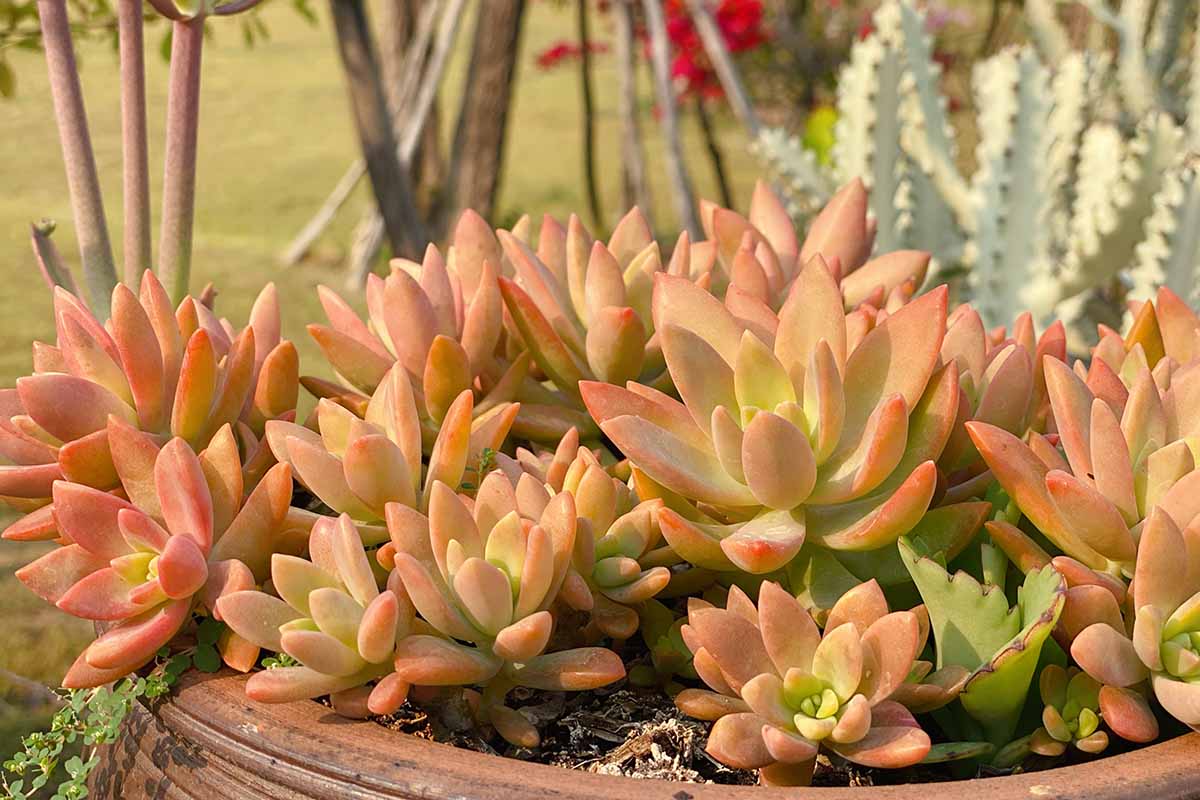
In shady locations, the foliage is a yellowish-green color, but in a sunny spot the leaves take on a gorgeous coppery-red hue.
Tiny star-shaped white flowers appear in spring.
This species tops out at eight to nine inches tall and spreads two to three feet.
It’s ideal for front of beds and borders, rock gardens, and in hanging baskets.
You can find coppertone sedum in 2.5-inch pots available from Hand Picked Nursery via Walmart.
11. Coral Carpet
S. album ‘Coral Carpet,’ aka white stonecrop, has a preference for full sun and tolerates poor, dry soil.
The foliage is thick and needle-like, turning from green to reddish-brown in the fall. Summer blossoms are white to light pink.
Suited to Zones 3 to 9, plants grow to a petite four to six inches tall and six to nine inches wide.

Best uses include naturalizing as a ground cover and placements in the fronts of borders.
‘Coral Carpet’ sedum is available on Amazon.
12. Corsican
S. dasyphyllum, or Corsican stonecrop, prefers full sun. It has gray-green foliage resembling thick flower petals that shade to purple with chilling or drought conditions.
The flowers are white with pink accents.
Plants grow in Zones 5 to 9 and reach a petite stature of one to two inches tall and six to eight inches wide.

Naturalize as a ground cover; fill in niches in paths, rockeries, and walls; or sow in low-profile roof gardens.
Corsican sedum is available on Amazon.
13. Donkey’s Tail
Donkey’s tail, S. morganianum, prefers full sun. It has tail-like foliage that resembles a burro or donkey’s tail.
Mature dimensions reach an impressive four feet long and one and a half feet wide.
These plants grow outdoors in Zones 10 to 11 and they are popular houseplants for all regions.
Let them spill over garden walls, hanging planters, and vertical green walls that emphasize the cascading tails.
Donkey’s tail is available from Nature Hills.
Our donkey’s tail growing guide has more information.
14. Dragon’s Blood
S. spurium (syn. P. spurius) ‘Dragon’s Blood,’ aka ‘Schorbuser Blut,’ prefers a full-sun placement and dry conditions. It has green leaves with red margins and pink late-season flowers.
Suited to Zones 4 to 9, plants grow to low-profile heights of four to six inches with a spread of 12 to 18 inches.
Best uses include naturalizing as a ground cover, and filling in wall crevices and border fronts.
‘Dragon’s Blood’ is available from True Leaf Market.
It is also available from Nature Hills.
15. Firecracker
Sedum x Sunsparkler® ‘Firecracker’ prefers full sun and dry conditions.
It emerges with mint green foliage that shades burgundy for the season. Pink flowers grace the upright stems from late summer to fall.
This cultivar grows in Zones 4 to 10 and reaches petite heights of six to eight inches with an equal spread.
With its deep hue, this little beauty makes a striking and unexpected ground cover for hard-to-mow slopes and an equally inviting edging for pathways.
‘Firecracker’ is available from Nature Hills.
16. Firestorm
S. adolphi Firestorm™ is a cultivated variety of the coppertone sedum, featuring greenish yellow pointed leaves with deep red edges.
When planted in full sun locations, the foliage turns bright red.

It’s a low-growing, ground cover type, with a height of just eight inches, and a spread of one to two feet.
Firestorm™ is drought-tolerant and thrives in lean, well-draining soil. Hardy in Zones 10 and 11, it’s ideal in rock gardens and xeriscapes.
17. Frosted Fire
Upright, clumping ‘Frosted Fire’ is a variegated sport of ‘Autumn Fire’ that also boasts rosy flowers but has green leaves with cream margins.
It prefers full sun and tolerates drought and salt.
For Zones 3 to 9, ‘Frosted Fire’ grows to heights of 12 to 15 inches with a spread of 18 inches.
Use it in hard-scrabble trouble spots beside paved areas and in salty, coastal regions.
‘Frosted Fire’ is available from Nature Hills.
18. Frosty Morn
S. erythrostictum (syn. H. erythrostictum) ‘Frosty Morn’ is an upright, clump-forming stonecrop with variegated foliage.
The green, succulent leaves are edged in cream adding texture to beds and borders. In late summer, clusters of tiny pinkish-white flowers appear, lasting into fall.
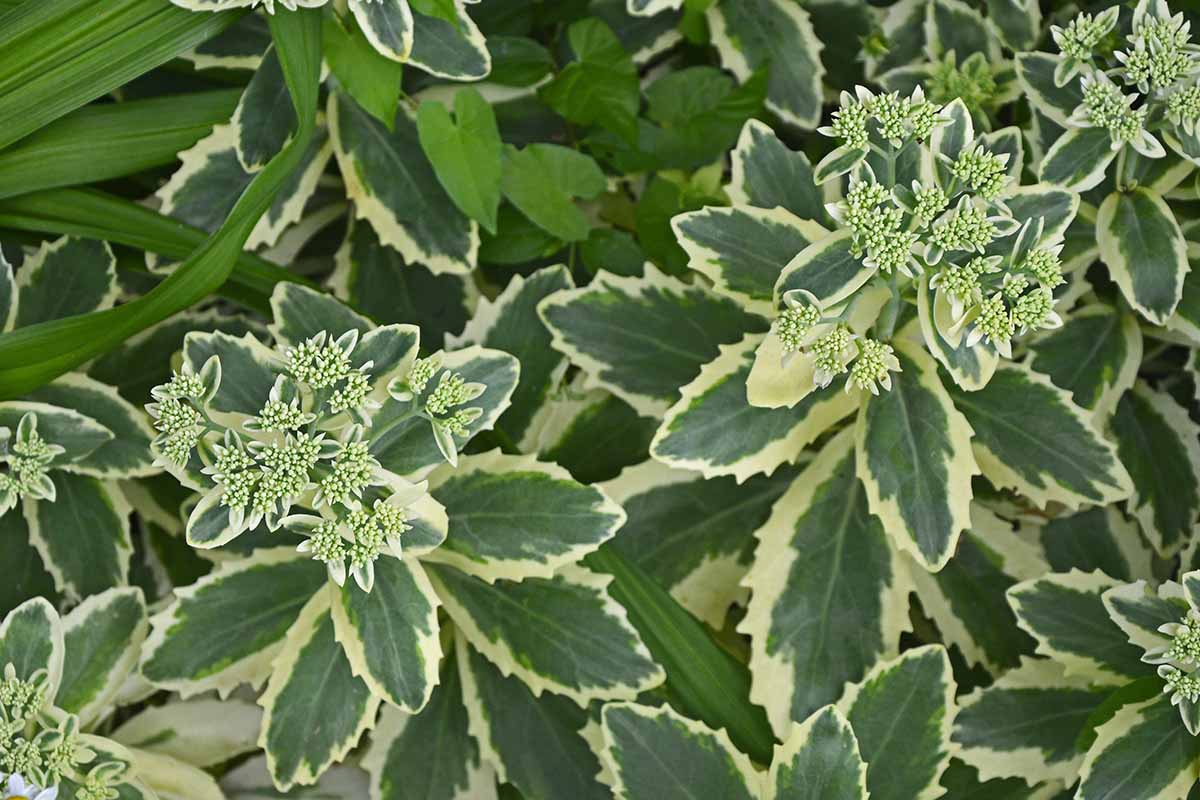
‘Frosty Morn’ is hardy in Zones 3 to 9, and grows to a mature height of 10 to 12 inches, with a similar spread.
It’s drought- and salt-tolerant, and prefers well-drained, lean soil in a full sun location.
19. Golden Glow
‘Golden Glow’ is a hybrid, sometimes listed as S. adolphi. It sports thick, fleshy leaves that form loose rosettes on stems up to 12 inches long. The foliage is bright yellowish-green with orange edges.
It’s hardy in Zones 3 to 9 and enjoys a full sun location and well-draining soil.
You can find ‘Golden Glow’ plants in two-inch pots available at Walmart.
20. Goldmoss
S. acre, aka goldmoss or biting stonecrop, grows low to the ground, forming mat-like clumps of deep green leaves and tiny yellow flowers.
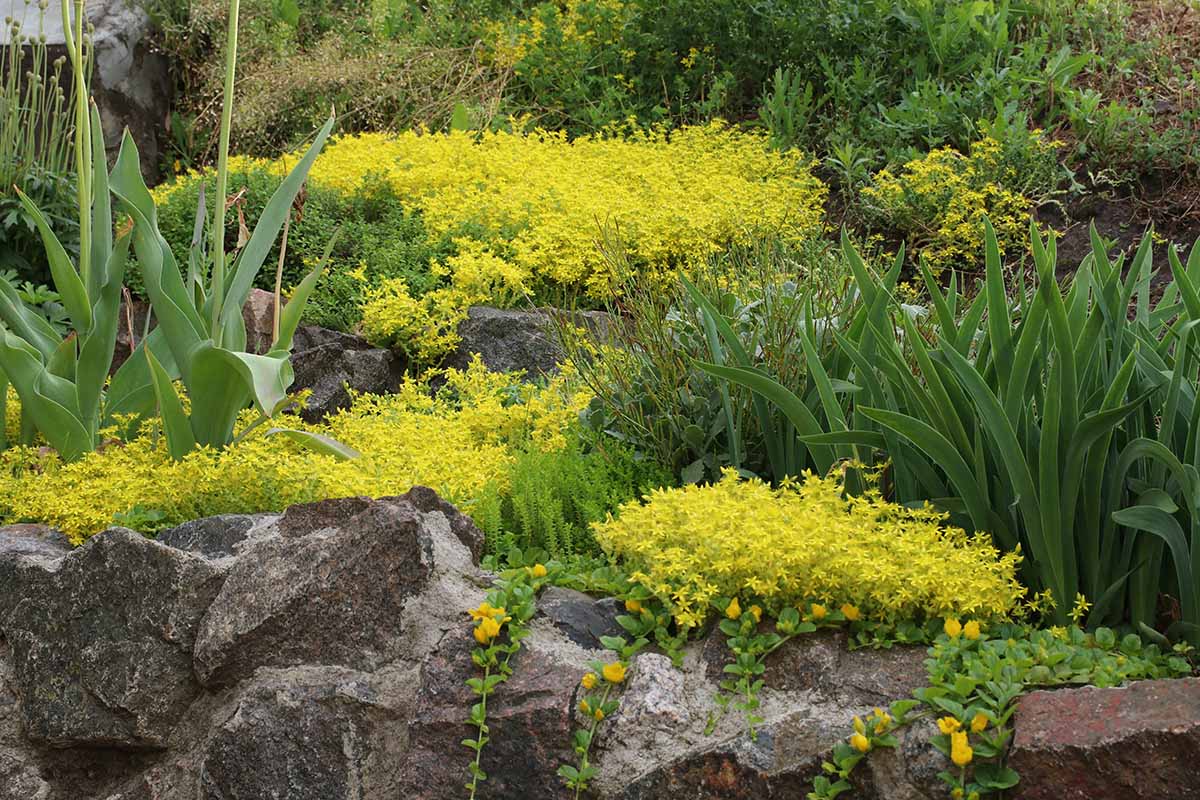
Ideal as a ground cover in rock gardens, goldmoss sedum grows three inches tall and can spread up to two feet.
Goldmoss will thrive in full sun to part shade, and prefers lean, well-draining soil.
21. Jelly Bean
S. x rubrotinctum, aka jelly bean plant or pork and beans, prefers full sun and dry conditions.
It has plump, needle-style leaves that start green and shade red during the growing season.
Long-term sun exposure enhances the red tones, and yellow flowers complement them in the summer.
Enjoy jelly bean outdoors in Zones 10 to 11 and indoors in all regions. Mature heights are six to eight inches with a spread of eight to 12 inches.
Jelly bean sedum shines in dry, pebbly areas where other plants fail to thrive.
This species is available from Nature Hills.
22. Lemon Coral
Like ‘Angelina,’ S. mexicanum Lemon Coral®, aka ‘Lemon Ball,’ has needle-like chartreuse leaves and yellow summer blooms.
However, its exceptional drought and heat tolerance and preference for dry soil make it well-suited to Zones 7 to 11, where it grows to a height of three to nine inches with a width of 12 to 24 inches.
Showcase this sedum variety in borders, containers, hanging planters, and sunny window boxes.
Lemon Coral is available from Nature Hills.
23. Lemon Drop
‘Lemon Drop’ is a hybrid that prefers partial shade. It has oval, scallop-shaped, spring-green foliage, and yellow flowers in late summer to fall.
Plants grow in Zones 4 to 9 and benefit from supplemental water if it doesn’t rain. Plants mature to a height of six inches with a width of eight to 12 inches.
Display it in planters, borders, and beds.
‘Lemon Drop’ is available from Nature Hills.
24. Lime Zinger
Sunsparkler® ‘Lime Zinger’ sedum prefers full sun and is notably drought resistant. It has red-edged green foliage and late-season pink flowers.
Plants grow in Zones 4 to 9. Mature dimensions are a petite four to six inches tall and six to eight inches wide.
Its tolerance for poor soil, drought, and heat makes ‘Lime Zinger’ a useful ground cover in problem areas like gravelly driveway, roadway, and sidewalk edges.
‘Lime Zinger’ is available from Nature Hills Nursery.
25. Mr. Goodbud
‘Mr. Goodbud’ is a hybrid sedum that prefers full sun and tolerates drought well.
It is an upright, clumping variety with two-tone pink flowers that shade dark mauve. The flower heads are dense and exceptionally large.
This cultivar thrives in Zones 4 to 9. It matures to 12 to 24 inches tall and wide.
Display it as a specimen with other late-season flowers or mass plant along borders for a dramatic impact.
‘Mr. Goodbud’ is available from Nature Hills.
26. October Daphne
S. sieboldii (syn. H. sieboldii), aka October daphne is a low-growing sedum with a spreading growth habit.

The blue-green leaves are borne on six- to 10-inch stems that trail attractively over the side of containers or stone walls.
The stems grow outwards from a central crown, giving the plant a rounded appearance.
In the summer, the foliage develops pinkish-red edging. Come fall, October daphne blooms with bright pink flowers. It’s hardy in Zones 3 to 9, and thrives in lean, well-draining soil.
27. Purple Emperor
‘Purple Emperor,’ an S. telephium (syn. H. telephium) hybrid, prefers a full-sun placement. It has an upright, clumping growth habit, burgundy foliage, and pink summer-to-fall flowers.
Plants are suited to Zones 3 to 9. Mature heights and widths are 12 to 24 inches.
Group with green-leafed annuals and perennials for a striking contrast in beds and borders.
‘Purple Emperor’ is available from Nature Hills.
28. Sweet and Sour
The foliage of S. kamtschaticum (syn. Phedimus kamtschaticus) ‘Sweet and Sour’ prefers full sun.
The foliage starts out yellow and deepens to green for a variegated look that pops in summer gardens, especially when the yellow flowers bloom.
This petite cultivar grows in Zones 4 to 9, reaching mature heights of six to eight inches with a spread of 10 to 15 inches.
Mass plant as edging around paved areas and patios.
‘Sweet and Sour’ is available from Nature Hills.
29. Steel the Show
S. cauticola (syn. H. cauticola) ‘Steel the Show’ prefers a full-sun placement. It has gray-blue foliage and rose-colored fall blooms.
Suited to Zones 3 to 8, ‘Steel the Show’ reaches mature heights of six to eight inches with a spread of 14 to 16 inches.
Best uses include borders, edging, ground covers, and rock gardens.
‘Steel the Show’ is available from Nature Hills Nursery.
30. Touchdown Flame
Touchdown™ Flame is part of the Touchdown™ series of autumn stonecrops, bred by Terra Nova nurseries.
It’s a S. telephium (syn. H. telephium) hybrid, with glossy leaves that emerge bright red and green before transforming to deep burgundy as the summer progresses.
Compact plants top out at eight inches tall and bloom in late summer to early fall with creamy yellow flowers. It’s hardy in Zones 4 to 9, and is drought tolerant once established.
It’s ideal for front of border placements or growing in containers.
31. Vera Jameson
‘Vera Jameson’ is a naturally-occurring hybrid sedum, discovered by an English gardener of the same name.
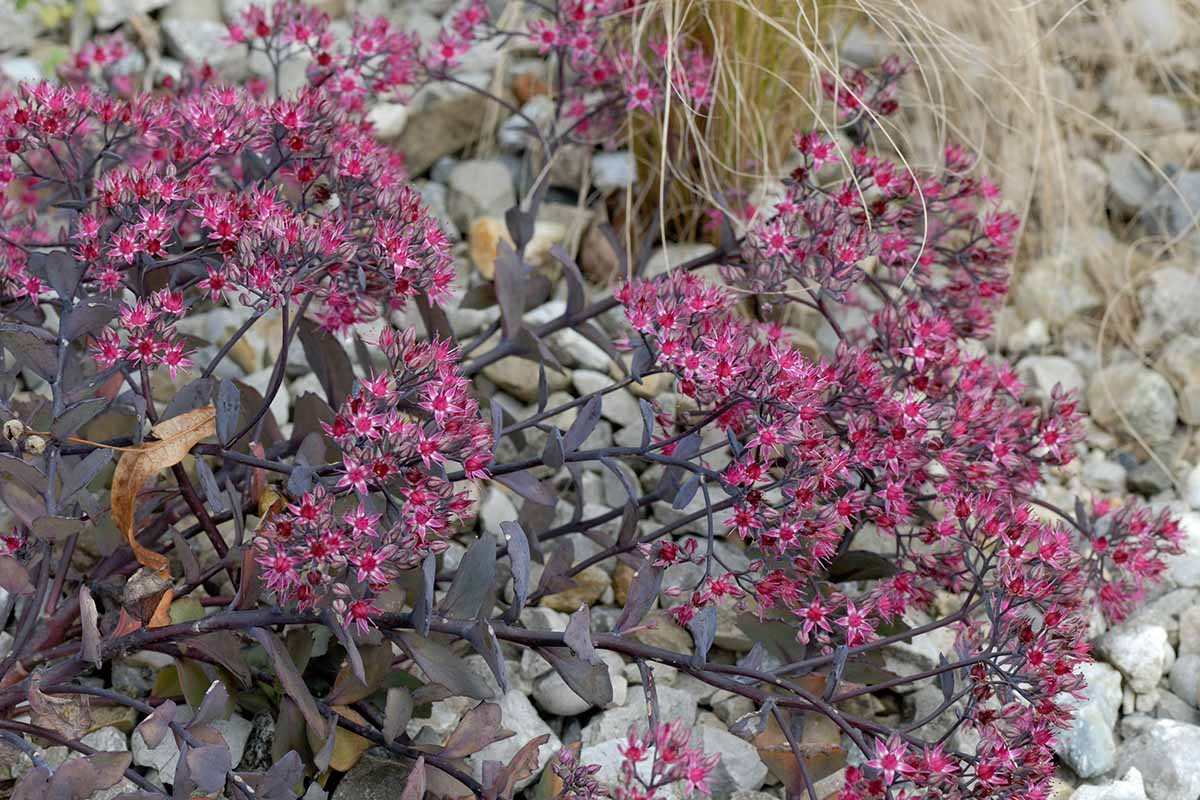
It forms attractive, nine- to 12-inch-tall clumps of purplish-green leaves, and blooms in mid- to late summer with light pink flowers.
Hardy in Zones 3 to 9, ‘Vera Jameson’ appreciates sandy, lean soils and a full-sun location.
Turn Up the Excitement
If you haven’t tried sedum before, it’s time to add it to your garden planner.
Low-profile, ground-covering varieties form a carpet of color that is dense enough to keep the weeds away but not too thick for spring bulbs to grow through.
Use them in beds, borders, containers, rockeries, roof gardens, and vertical green walls.
You’ll appreciate the summer blossoms and how well the foliage softens hard edges, fills in gaps, and inhibits erosion.
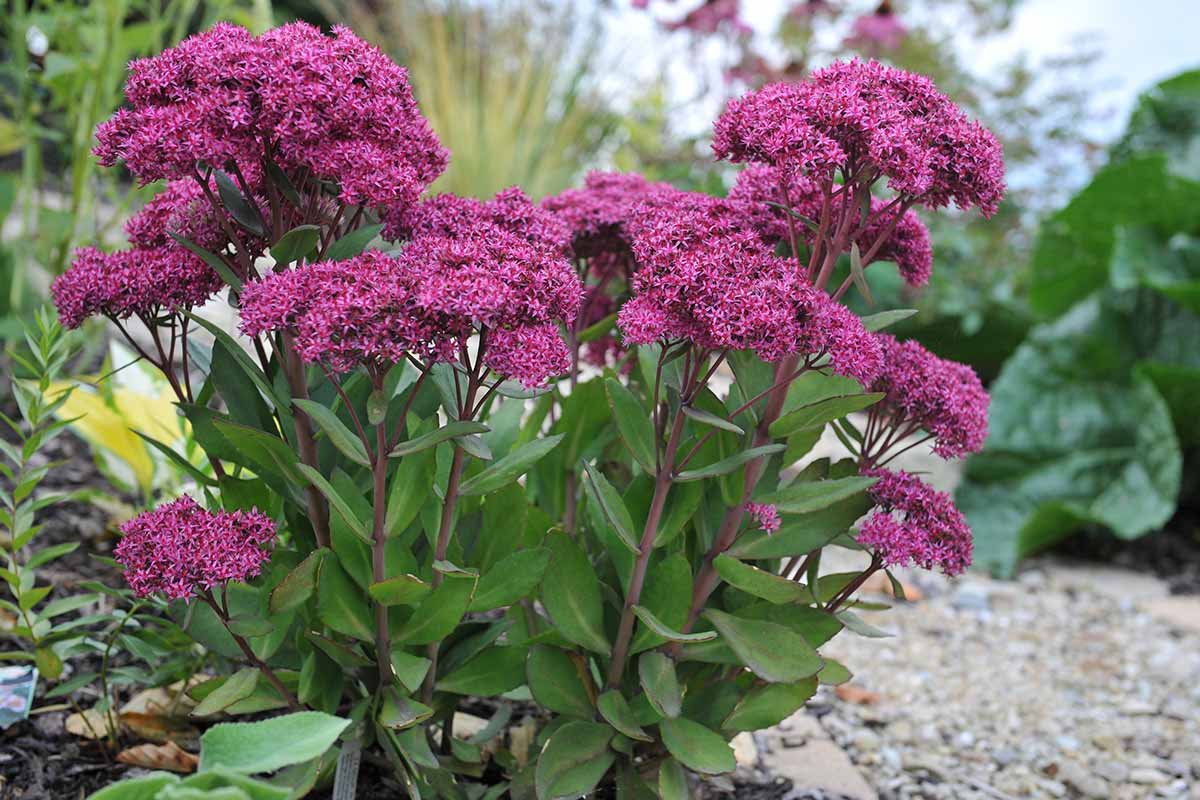
Taller, upright sedums sport dense, flattened flower heads for ribbons of color that light up beds and borders with red, rose, and russet as the growing season winds down.
It’s time to turn up the excitement in your outdoor living space with the richly-hued succulent foliage and starry blossoms of sedum.
Do you grow sedum? What are your favorites? We invite you to tell us in the comments section below.
If you enjoyed this article and have a passion for succulent plants, we recommend reading the following next:
